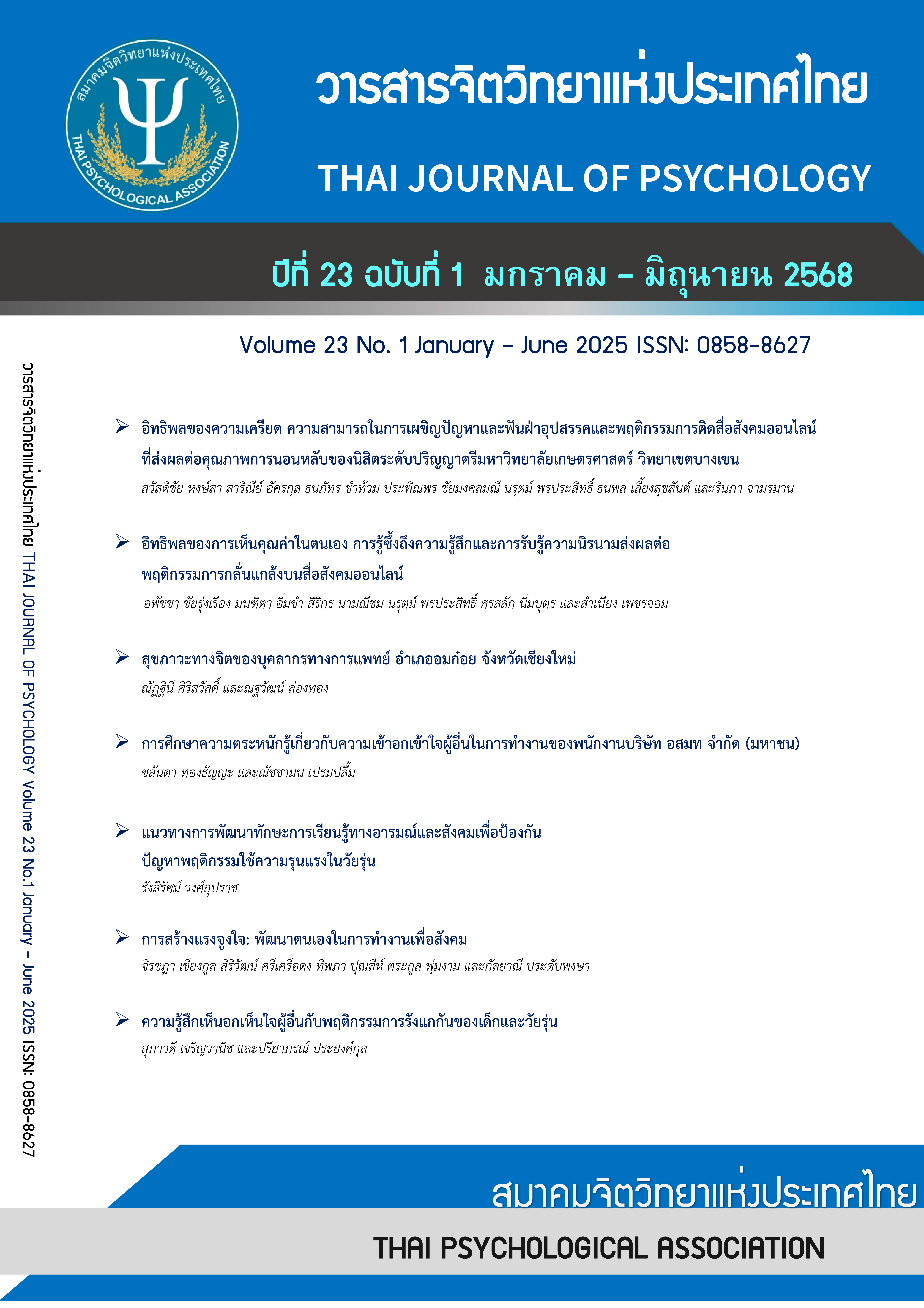การศึกษาความตระหนักรู้เกี่ยวกับความเข้าอกเข้าใจผู้อื่นในการทำงานของ พนักงาน บริษัท อสมท จำกัด (มหาชน)
คำสำคัญ:
ความเข้าอกเข้าใจ, แนวทางการพัฒนาความเข้าอกเข้าใจ, การทำงานของพนักงาน, พนักงานบทคัดย่อ
การวิจัยครั้งนี้ มีวัตถุประสงค์เพื่อศึกษาความตระหนักรู้เกี่ยวกับความเข้าอกเข้าใจผู้อื่นในการทำงานของผู้บริหารและพนักงาน บริษัท อสมท จำกัด (มหาชน) รวมถึงข้อเสนอแนะแนวทางพัฒนาความเข้าอกเข้าใจผู้อื่นในการทำงานของผู้บริหาร บริษัท อสมท จำกัด (มหาชน) กลุ่มตัวอย่าง เป็นผู้บริหารและพนักงาน จำนวน 16 คน (ผู้บริหาร 6 คน และพนักงานระดับปฏิบัติการ 10 คน) เครื่องมือที่ใช้ในการวิจัย ได้แก่
การสัมภาษณ์เชิงลึกด้วยคำถามปลายเปิด เกี่ยวกับความเข้าอกเข้าใจผู้อื่นในการทำงาน เพื่อให้กลุ่มตัวอย่างสามารถคิดวิเคราะห์ เรียบเรียงคำตอบออกมาได้อย่างครบถ้วน และตรงต่อวัตถุประสงค์การศึกษา ซึ่งจากการวิจัย พบว่ากลุ่มตัวอย่างมีความตระหนักรู้เกี่ยวกับความเข้าอกเข้าใจที่มีต่อเพื่อนร่วมงานภายในองค์กร เนื่องจากมีองค์ประกอบของความเข้าอกเข้าใจผู้อื่น ครบทั้ง 5 องค์ประกอบ ตามแนวคิดของ Goleman (1998) ได้แก่
การทำความเข้าใจผู้อื่น การพัฒนาส่งเสริมผู้อื่น การวางแผนบริการ การใช้ประโยชน์จากความหลากหลาย และการตระหนักรู้สถานการณ์กลุ่ม ในส่วนของแนวทางพัฒนาความเข้าอกเข้าใจผู้อื่นจากกลุ่มตัวอย่างผู้บริหาร เสนอไว้ 2 แนวทาง คือ การกำหนดเป้าหมายร่วมกันเพื่อพัฒนาการทำงานเป็นทีม และการทำกิจกรรมเพื่อพัฒนาความเข้าอกเข้าใจ ที่ช่วยให้เข้าใจและรู้สึกถึงอารมณ์ของผู้อื่นได้มากขึ้น พัฒนาความสัมพันธ์ระหว่างบุคคลในการอยู่ร่วมกันในสังคมการทำงาน และเสริมประสิทธิภาพที่ดีภายในองค์กรได้
เอกสารอ้างอิง
เอกสารอ้างอิง
มูลนิธิยุวพัฒน์. (20 พฤศจิกายน 2566). Empathy การเห็นอกเห็นใจผู้อื่น. สืบค้นจาก https://www.yuvabadhanafoundation.org/th/ข่าวสาร/บทความทั่วไป/empathy-mental-health/
นภดล ร่มโพธิ์. (2 กรกฎาคม 2562). ทุกเรื่องที่อาจยังไม่เคยรู้ของ OKR จาก ศ.ดร.นภดล ร่มโพธิ์.
The Standard. สืบค้นจาก https://thestandard.co/podcast/thesecretsauce126/
สมาคมนักข่าวนักหนังสือพิมพ์แห่งประเทศไทย. (2567). รายงานสถานการณ์สื่อมวลชนในรอบปี 2567
: ปีแห่งความยากลำบากของสื่อมวลชน. สืบค้นจาก https://tja.or.th/view/activities/media-situation/1453282
สหธร เพชรวิโรจน์ชัย. (2564). รู้จัก Empathy Skill ทักษะที่ทำให้เข้าใจความรู้สึกคนอื่นมากขึ้น. สืบค้นจาก https://th.hrnote.asia/orgdevelopment/empathy-skill-210714/
สุภางค์ จันทวานิช. (2559). วิธีการวิจัยเชิงคุณภาพ (พิมพ์ครั้งที่ 23). จุฬาลงกรณ์มหาวิทยาลัย.
A Britain Healthiest. (2015). Health, wellbeing and productivity in the workplace: A Britain's Healthiest Company summary report. RAND Corporation, UK. https://www.rand.org/pubs/research_reports/RR1084.html
Baron-Cohen, S., & Wheelwright, S. (2004). The Empathy Quotient: An investigation of adults with Asperger Syndrome or High Functioning Autism, and normal sex differences. Journal of Autism and Developmental Disorders, 34(2), 163-175. https://doi.org/10.1023/b:jadd.0000022607.19833.00
Batson, C. D. (1991). The altruism question: Toward a social psychology of compassion and caring. Psychology Press.
Boddy, C. R. (2016). Sample size for qualitative research. Qualitative Market Research: An International Journal, 19(4), 426-432.
Businessolver. (2017). 2017 Workplace empathy monitor Report. https://info.businessolver.com/hubfs/businessolver-workplace-empathy-monitor-2017.pdf
Chartered Institute of Personnel and Development. (2023). Health And Wellbeing At Work Survey Report. https://www.cipd.org/globalassets/media/knowledge/knowledge-hub/reports/2023-pdfs/8436-health-and-wellbeing-report-2023.pdf
CPP Global. (2008). Workplace Conflict And How Businesses Can Harness It To Thrive. https://shop.themyersbriggs.com/Pdfs/CPP_Global_Human_Capital_Report_Workplace_Conflict.pdf
Fox, J., & Moreland, J. J. (2015). The dark side of social networking sites: An exploration of the relational and psychological stressors associated with Facebook use and affordances. Computers in Human Behavior, 45, 168-176. https://doi.org/10.1016/j.chb.2014.11.083
Goleman, D. (1998). Working with Emotional Intelligence. Bantam Books.
Goleman D. (2001). An EI-based theory of performance. In C. Cherniss & D. Goleman (Eds.), The Emotionally Intelligence Workplace, (1st ed. pp. 27-44). Jossey-Bass.
Google Trends. (2024). Search term: Empathy. https://trends.google.com
Hoffman, G. D. (2009). Applying principles of leadership communication to improve mediation outcomes. Dispute Resolution Journal, 64(3), 24-29. http://www.digitalsmarttools.com/eHoffmann/Hofffmann-Docs/Applying_Principals_of_Leadership_Communication_to_Improve_Mediation_Outcomes.pdf
Holt, S. (2022). Nurturing empathy. In J. Marques (Ed.), Innovative Leadership in Times of Compelling Changes (pp. 117-131). Springer.
Keen, S. (2007). Empathy and the Novel. Oxford University Press.
Krauss, R. M., & Fussell, S. R. (1991). Perspective-taking in communication: Representations of others' knowledge in reference. Columbia University. https://www.columbia.edu/~rmk7/HC/HC_Readings/Krauss_Fussell.pdf
Krueger, R. A. (1998). Moderating Focus Groups, (pp. 137-142). Sage Publications. https://doi.org/10.4135/9781483328133
Lyubykh, Z. & Gulseren, D.B. (2023, 31 May). How to Take Better Breaks at Work, According to Research. Harvard Business Publishing, Health and wellness Digital Article. https://hbr.org/2023/05/how-to-take-better-breaks-at-work-according-to-research
Mayer, K. (2020). HRE’s number of the day: Coronavirus stress. Human Resource Executive. https://hrexecutive.com/hres-number-of-the-day-coronavirus-stress/
Moore, K. J., Xiong, S., Bhattacharya, M., Bustamante, G., & Calvert, C. (2020). Beyond diversity: focusing on and enhancing inclusion in the Society for Epidemiologic Research. American Journal of Epidemiology, 189(10), 1042-1046.
Rahman, W. (2016). Empathy and trust: Into a better workplace environment. Journal of Business and Economics, 7(12), 2090-2099.
Ritchie, J. & Spencer, L. (2002). Qualitative Data Analysis for Applied Policy Research. In A. M. Huberman, & M. B. Miles (Eds.), The Qualitative Researcher’s Companion. SAGE Publications.
Rogers, C. R., & Richard, E. F. (1987). Active listening. In R.G. Newman, M.A. Danzinger, & M. Cohen (Eds.), Communicating in Business Today. D.C. Heath & Company.
Sadri, G. (2012). Emotional intelligence and leadership development. Public Personnel Management, 41(3). https://doi.org/10.1177/009102601204100308
เผยแพร่แล้ว
รูปแบบการอ้างอิง
ฉบับ
ประเภทบทความ
สัญญาอนุญาต
ลิขสิทธิ์ (c) 2025 สมาคมจิตวิทยาแห่งประเทศไทย

อนุญาตภายใต้เงื่อนไข Creative Commons Attribution-NonCommercial-NoDerivatives 4.0 International License.
บทความที่ได้รับการตีพิมพ์เป็นลิขสิทธิ์ของสมาคมจิตวิทยาแห่งประเทศไทย
ข้อความที่ปรากฎในบทความแต่ละเรื่องในวารสารวิชาการเล่มนี้เป็นความคิดเห็นส่วนตัวของผู้เขียนแต่ละท่านไม่เกี่ยวข้องกับสมาคมจิตวิทยาแห่งประเทศไทย แต่อย่างใด ความรับผิดชอบองค์ประกอบทั้งหมดของบทความแต่ละเรื่องเป็นของผู้เขียนแต่ละท่าน หากมีความผิดพลาดใด ๆ ผู้เขียนแต่ละท่านจะรับผิดชอบบทความของตนเองแต่ผู้เดียว






